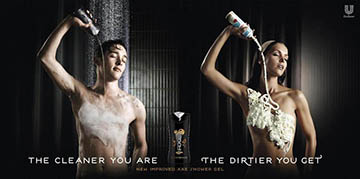
| One of the ways the ads incentivize the use of their body wash is through the threat of emasculation, a threat that is especially effective against young men. "As young men we are constantly riding those gender boundaries," states sociologist Michael Kimmel, "checking the fences we have constructed on the perimeter, making sure that nothing even remotely feminine might show through. The possibilities of being unmasked are everywhere" (Kimmel 215). In addition to the tautological "smell like a man, man", Old Spice ads warn us, "don't be a man whose body wash makes him smell like a woman", ostensibly as if this would be bad, cultivating and contributing to "the male fear of appearing too concerned with fashion, of being too pretty," of failing to achieve the masculine ideal (Gladwell 190). The addition of "especially if you're already named Jamie", with Jamie being a gender-ambiguous name, uses the word "especially" to correlate the inadvisablity of an action with how much it leads to unclear gender presentation. Its imperative command is presented on a regime of truth, according to Focault's terminology, that states that androgyny and ambiguity are things to be avoided, and that men should take pains not to bear similarity to women. |

|

|
Sexual reward is also one of the tactics employed: "the cleaner you are, the dirtier you get", with "dirtiness" metaphorically referring to sexual activity (as can be inferred by the images of naked, feminine-coded figures above that section of the phrase, holding objects intended to be sexually suggestive). Media scholar Rebecca Feasey has argued, looking at Lynx (Axe) ads specifically, that seduction and the acquisition of (female) sexual partners is "one way in which men compete with other men, prove their masculinity and thus position themselves within the hegemonic hierarchy" (Feasey 367). In general, "women become a kind of currency that men use to improve their ranking on the masculine social scale" (Kimmel 214). The images in this particular series of ads draw a direct connection between the use of Axe body wash and naked women. Oddly enough, however, if the "you" in "the dirtier you get" is meant to be the male viewer, or even the masculine-coded figure shown on the left, then the "you" in the scene on the right is not pictured; "you", yourself, are not the one who is acting sexually. Rather, "you get" dirtier. That is, dirtiness (naked women acting sexually) is delivered to you. Interestingly, even though the masculine- and feminine-coded figures are posed similarly, both naked, and displayed as echoes of each other, more skin from the latter is shown, especially in the ad with the figures' backs to the camera -- which can be interpreted as a retreat from andro-erotic readings. The lack of a masculine-coded figure in the second scene, which is presumably intended for a straight male audience and depicting what is either ongoing or a prelude to heterosexual sexual activity, contributes to this impression. Otherwise, why not have the "you" of "the cleaner you are" pictured in the act? In the formation of discourse, "absences can be as productive as explicit naming; invisibility can have just as powerful effects as visibility" (Rose 219). Through displaying comparatively more of the feminine-coded figure, the ad implicitly asserts that the sight of female flesh is more desirable than the sight of male flesh, upholding a heteronormative male gaze. The same pattern is upheld throughout the sample: below the waist, masculine-coded figures are meticulously covered and hidden in ways that feminine-coded figures rarely are, limiting the potential for a presumed-male reader to engage in queer viewing. |
|

|

| |
|
Axe Ad 1. N.d. Graphic. Adpressive. Web. 4 Mar 2014. (http://adpressive.com/wp-content/uploads/2013/01/axe-clean-dirty.jpg). Axe Ad 2. N.d. Graphic. MsMagazine. Web. 4 Mar 2014. (http://www.msmagazine.com/summer2011/images/nocomment_axe.jpg). Feasey, Rebecca. "Spray More, Get More: Masculinity, Television Advertising And The Lynx Effect." Journal Of Gender Studies 18.4 (2009): 357-368. Academic Search Complete. Web. 29 Mar. 2014. Gladwell, Malcom. "Listening to Khakis." The Gender and Consumer Culture Reader. New York: New York University Press, 2000. Print. Kimmel, Michael S. "Masculinity as homophobia: Fear, shame, and silence in the construction of gender identity." Race, Class, and Gender in the United States: An Integrated Study. Ed. Paula S. Rothenberg. New York: Worth (2004): 81-93. Old Spice Ad 4. N.d. Graphic. GGPHT. Web. 4 Mar 2014. (http://lh6.ggpht.com/_QjuvIeixiOs/S3m937mddUI/AAAAAAAACHo/zwDK0WdCZ8Q/s800/old%20spice.jpg). Rose, Gillian. Visual Methodologies. 3rd ed. London: SAGE Publications, 2012. Print. |